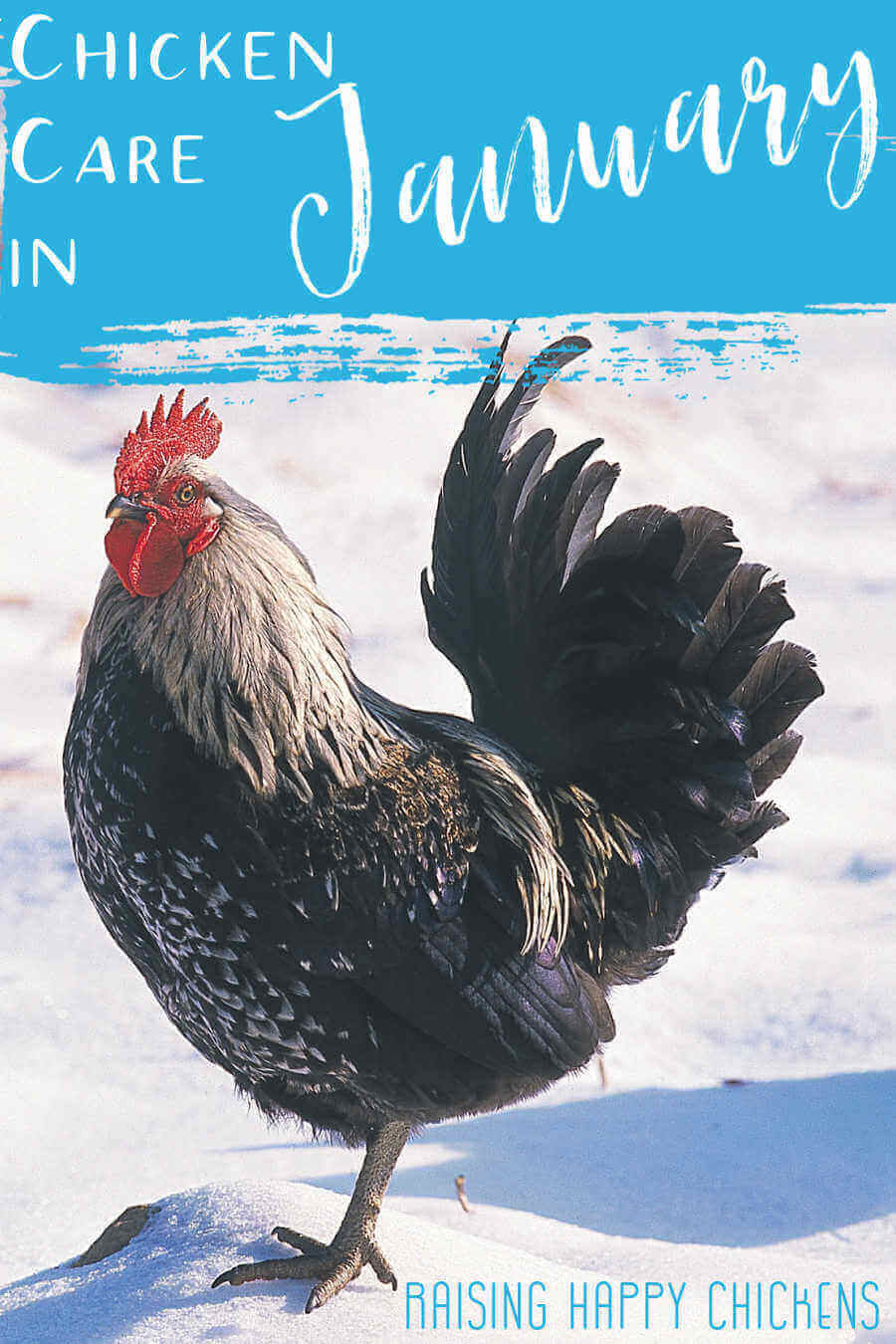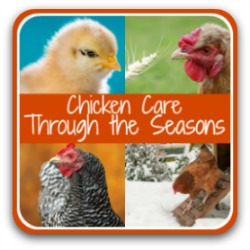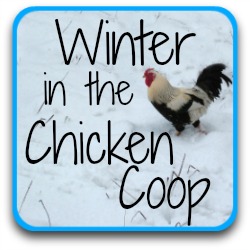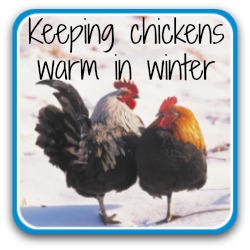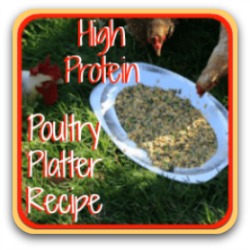- Home
- Monthly care
- January
Raising Chickens in January.
Are you in my newsletter group? If so, you'll be able to download your free checklist for this month's tasks from the newsletter which comes to you in the first week of the month.
If you're not in my newsletter group - why not join? You'll get a free checklist of tasks every month! Click here for more information.
25 tasks to keep your chickens happy and healthy into the New Year.
So the days have drawn in, the weather has grown colder, the wind chill is, well, chilly, and your flock is looking a lot less happy than they did in the balmy days of summer!
If you've been following along with my "chicken care through the seasons" articles, you'll know we've been planning for winter since early autumn.
We've already made sure the flock has a secure coop which is protected from draughts and damp, and secure against predators.
But in January, the weather is getting colder, windier and wetter. So that's where we'll start.
Step 1: Beat the Wind Chill!
It's this simple: your chickens like to be outside but the wind chill makes it unpleasant for them (as well as freezing your own nose off!).
You may notice chickens squatting, squinting or blinking in the wind as they try to minimise the wind's effects and stop getting grit in their eyes, if it's that kind of soil!
Although your flock will be able to withstand very cold weather by fluffing up (see this section of November's to-dos), wind whistling through their top coats to the skin underneath is a different matter. They can quickly become chilled and, if that's combined with damp, the danger is increased.
The answer is not to stop your flock enjoying the great outdoors - chickens love being able to forage, even in a limited space.
But it may be wise to limit them to areas which are more sheltered.
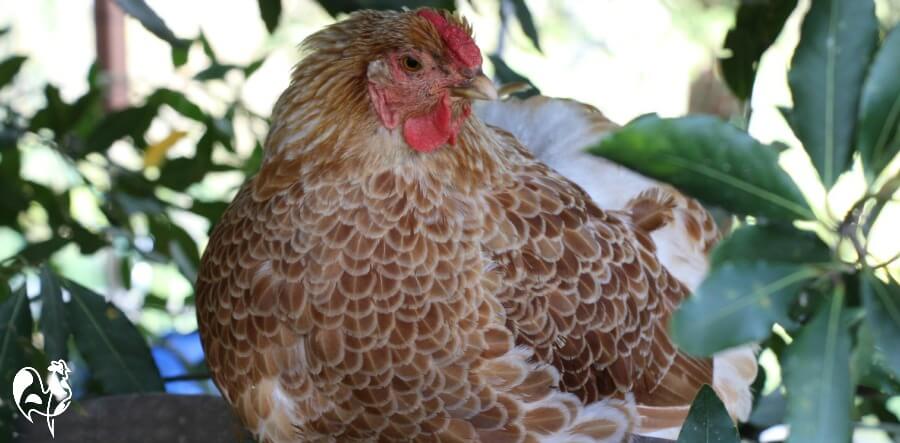 My chickens like to roost in any available bushes to get out of the wind - this is Henrietta in our bay tree!
My chickens like to roost in any available bushes to get out of the wind - this is Henrietta in our bay tree!What to do.
1. Allow your flock access to the outside, even if you think it's too cold. They will make the decision for themselves and you'll find as long as they can get to shelter, or back into their coop, that's exactly what will happen.
Mine will venture outside for short periods in January, and will instinctively head for more sheltered parts. Or else they give up and go back into the coop.
The exception to this is young chicks who are not yet fully feathered. They do not have the capacity to keep themselves warm.
So keep youngsters inside safely under a heat source until they have their adult feathering and the weather is warm enough for them.
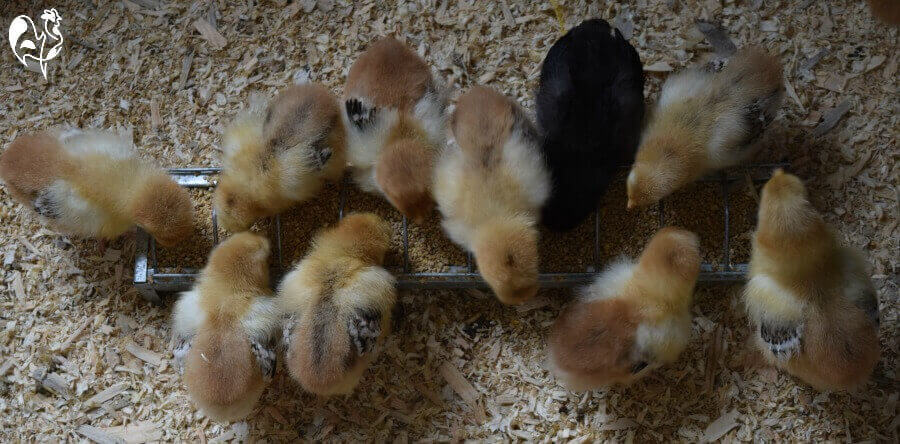 These chicks are mostly down - too young to go outside. Keep them under a source of warmth.
These chicks are mostly down - too young to go outside. Keep them under a source of warmth.2. If you have a very large run, which I do, you may want to block off some of it so that the area you make wind-proof is less large.
Cardboard is a good wind-break. Save up those packing cartons during the rest of the year and tie them to the fence of the run once the winter chills set in.
If you don't have any cardboard to hand, try your local recycling bins. Especially in the days after Christmas, there's often a generous supply of free cardboard to be had!
3. If your run doesn't have any natural protection like trees or bushes, try making a simple "lean-to". And make yourself a note to plant some trees in the spring. Mine has a large fig tree, a miniature apple and several bushes which I've planted specifically to allow shelter when necessary.
It's not only good for protection from the elements, but keeps the chickens safe from airborne predators, too.
4. Remember that cold plus damp can equal big problems for chickens. Frostbite is particularly troublesome. If you see any signs of it, take action straight away - see this article for more details about what to look for and what to do.
And if you're concerned that the January cold and damp is something you really can't control, be on the safe side and keep your flock inside, making sure they have some boredom-busters. A favourite for mine is "kill the swinging lettuce".
This is how it works.
If you purchase a product through some of the links on this page, I receive a small commission at no extra cost to you. I only recommend products I have purchased or would purchase myself and which I believe would benefit you. To learn more please see my disclosure policy.
Step 2: Beat winter boredom!
If the winter is particularly severe, your flock might have to remain inside.
The major problem with that is boredom. Yes, chickens do get bored. And that can lead to all kinds of behavioural problems: feather-picking, egg-eating and aggression among them.
What to do.
5. Read my detailed article about beating boredom in the chicken coop - it has a total of 25 easy ideas.
6. This is a popular one: make a DIY feed toy. Using a food grade plastic bottle such as an empty lemonade or water bottle), make several holes just large enough to allow feed to drop out. Fill it with your chickens' ordinary feed, or some wild bird seed for variety (this doesn't work with pellets) and watch them kick it round the coop.
7. Take a look in your local pet shop, or online, for some parrot toys. They won't last long outside, but can make great boredom busters inside the coop. Amazon now has a great range of chicken toys, too, although I find parrot toys have more variety.
8. Chickens are fascinated by mirrors. Find an old one (they don't mind cracks!), or look our for one in a thrift or charity shop. Pin it to the wall of your coop and watch them talk to the "other chicken"!
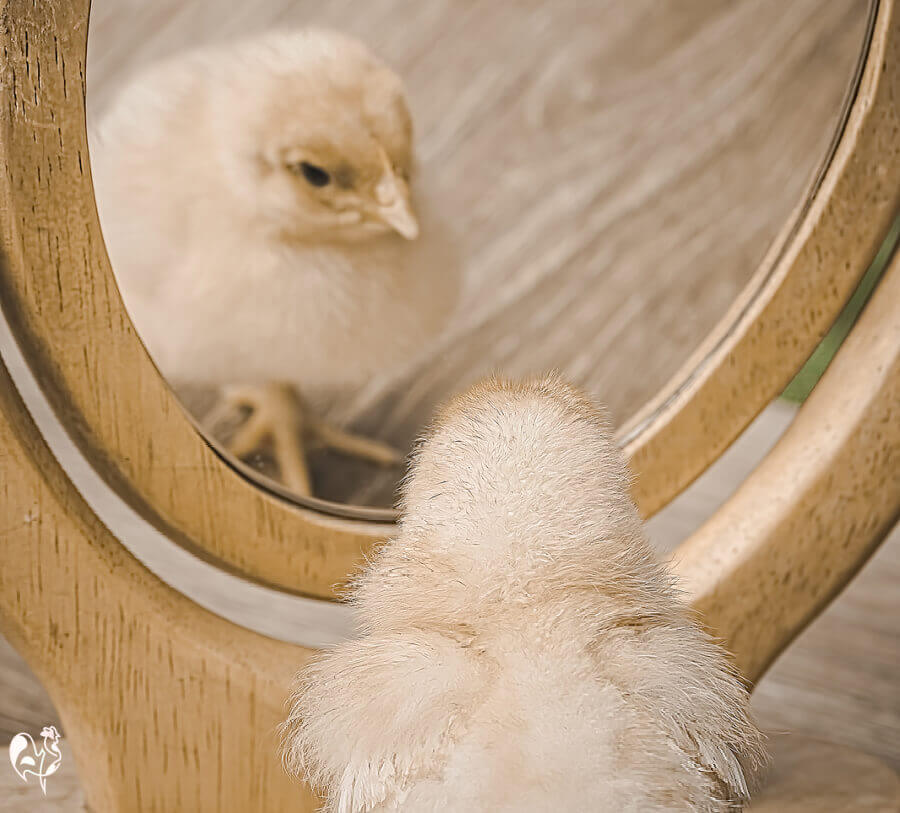 Chickens of all ages are fascinated by mirrors!
Chickens of all ages are fascinated by mirrors!Step 3: Raising chickens in the January cold: think before you heat.
I've said before that heating the coop in winter is unnecessary and potentially dangerous. I even have a Pinterest board dedicated to warning against it.
Yet every year, chicken-keepers tell me it's too cold in their area not to heat.
What to do.
9. Resist dressing your chickens in cute sweaters. I talked about this in December's to-dos, but it's worth repeating. If you missed it, here's a link.
This is really critically important. Every year friends and family send me "cute" pictures of chickens in sweaters.
Just don't do it. It's dangerous for your chickens' well-being.
10. Don't use exposed heat lamps in the coop. They're prone to burning out and sparking fires. Heat plus feathers is a recipe for disaster. Heat lamps cause more coop fires - and chicken deaths - than any other source (apart from commercial chicken farms, obviously).
Take a look at this article for more detail.
11. If you really can't be persuaded that chickens do not need additional heat even in quite extreme temperatures, consider something like this flat panel radiator.
It raises the temperature by just a few degrees and has no exposed bulbs.
12. Always make sure, when using any electrical product in your coop, that wires are kept in excellent condition and not exposed. Bored chickens will peck at just about anything they can find.
13. Should your electricity suddenly fail when you're heating your coop, your chickens will immediately be plunged back into freezing temperatures. The sudden temperature drop will cause a lot more problems than allowing them to cope with the cold would.
So if you do heat, make sure you have an alternative to hand.
See this article for more tips about keeping your flock warm in winter.
Step 4: Add some yummy garlic to feed!
Nothing much is growing in garden for chickens to eat in January, so it's important to look at taking over the garden's job by providing the goodies for chickens ourselves.
A great way of doing this which is easy, inexpensive and an amazing source of nutrients is to grow our own sprouted seeds. Granted, they're not my flock's first choice when it comes to yummy food, but at this time of year beggars can't be choosers, as they say!
Bear in mind, I live in Italy. Garlic is a staple of the diet - even for chickens! But I don't add anything to my chickens' food unless I'm sure it's not harmful, and preferably has evidence that it's beneficial.
There's no doubt that garlic does have benefits. See my article here which is based on properly researched evidence.
Does it make your flock's eggs taste of garlic? Research suggests not - unless you're going to add massive amounts to food or water. But in the quantities we're talking about, the answer is "no".
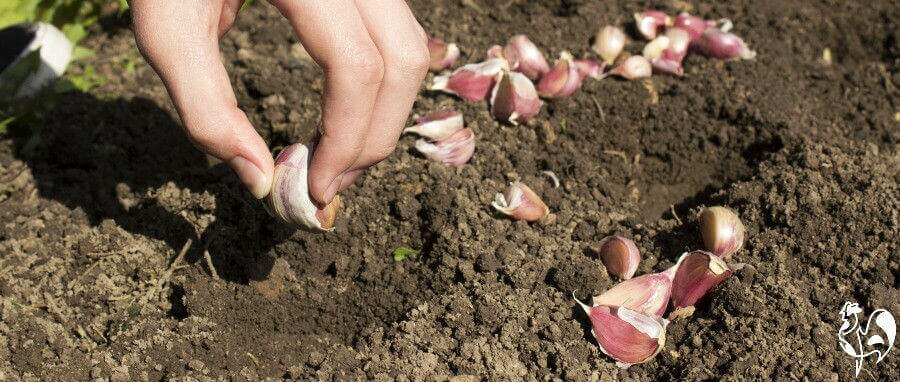 Planting garlic - an easy, inexpensive way to boost your flock's immune system.
Planting garlic - an easy, inexpensive way to boost your flock's immune system.What to do.
14. Garlic is one of the easiest crops to grow, but don't expect supermarket bulbs to do well. Even if they're not treated to prevent growth, the type may not be suited to your area, or may be prone to disease.
Buy bulbs from your local garden centre or nursery instead, or from a reputable online supplier.
15. Although it's best to sow the cloves (narrow end up!) in the late autumn (fall), it's still possible to plant in January, as they prefer to start life in a colder soil. Our soil is clay, and garlic prefers a light soil, so I use a planter box with garden compost.
16. Gail Damerow (an acknowledged expert in the poultry field) suggests feeding small amounts of crushed garlic to new chicks twice a week as a support to their immune system. This is something I'll be trying out in the Spring, when I hatch another brood.
For adult hens, crush four cloves and add to one gallon of water as a support to your chickens' immune system.
17. Not keen on adding fresh garlic, or don't have anywhere to plant it? Try a garlic powder mixed into their feed instead. Make sure it's organic and preferably non-GMO for the best quality.
This brand is certified organic. Beware imported products which contain unhealthy additives.
Step 5: Use the 'F' words to stock up on protein!
That is, Fish and Fermenting.
This time of year is one of the hardest for raising chickens. They're particularly susceptible to illness. Cold, damp air, not being able to forage as much, lack of green foods and the bounty of the rest of the year can all add up to poor immune systems.
And poor immune systems will inevitably lead to poor health.
So we need to do something to help boost our chickens' ability to fight off those bugs.
What to do.
18. Ever thought of fermenting, but not been too sure how to do it? It's really not difficult, and because of the efficient way it helps the body absorb food, it can even help save money.
So firstly, learn about the benefits of fermenting, here...
19. ... and then take the four simple steps outlined in this article to make your chickens some fermented food, today!
20. Fish is an amazing immune-boosting supplement at this time of year. High in beneficial Omega-3 oils and low in less healthy fats, it's an inexpensive way of offering your flock some variety in their diet.
Find out about the benefits - and a special inexpensive fishy recipe - here.
21. Remember: high protein foods, good as they are during winter months, should not take the place of regular feed. Look on them as treats, to be fed sparingly.
Bonus Step 6: Plan ahead for Spring chicks!
It seems that as soon as Christmas is over, everyone's thoughts (including mine!) turn to hatching chicks. Thoughts of the Spring and new life provide welcome relief from the cold and wet of a January winter.
But cute, fluffy chicks soon turn into noisy, smelly chickens - and roosters. And the sad fact is that more chickens are ending up in re-homing centres than ever before because families don't think through the possible difficult consequences.
So before you decide to incubate, make sure you're in a position to keep whoever hatches.
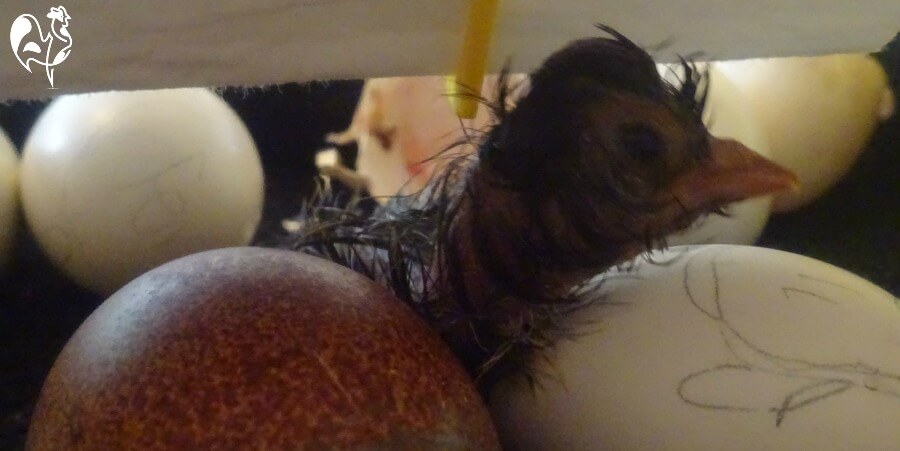 One of my newly hatched chicks - male or female? You won't be able to tell for several weeks. Are you prepared?
One of my newly hatched chicks - male or female? You won't be able to tell for several weeks. Are you prepared?What to do.
22. Check that it's legal to keep chickens wherever you live. This article will give you ideas about where to find the information.
Is your family ready to take on the responsibility of a flock of chickens - no matter how small? Take my quiz to find out.
23. Once you've decided you absolutely do want to start a flock - or add to your existing chickens - ask yourself whether hatching or buying makes more sense. Remember: hatching means you may end up with males. Take a look these links for the pros and cons of having roosters in your flock - if your area allows you to.
24. If you decide to go the incubating route, remember the equipment can be expensive. I review incubating equipment here - but you'll also need brooding equipment.
25. If you'd like to incubate and hatch with advice, and in a group, think about joining my hatching course which opens for registration in March. You'll find more information here, and updates will always be in my newsletter - sign up here.
More seasonal pages to help keep your chickens happy and healthy.
- Home
- Monthly care
- January
